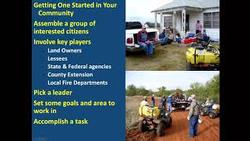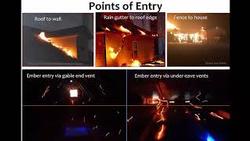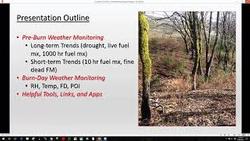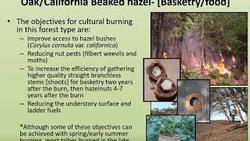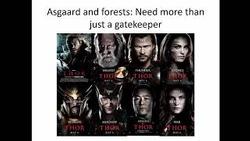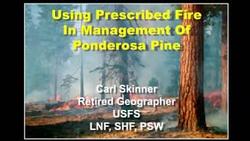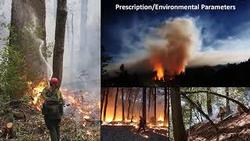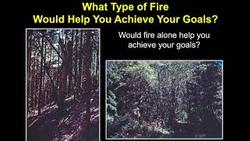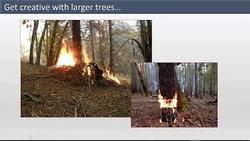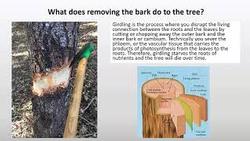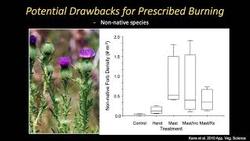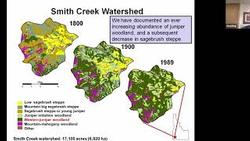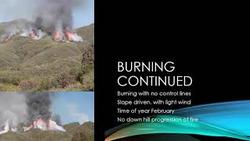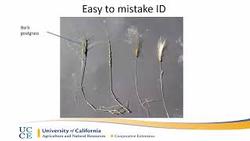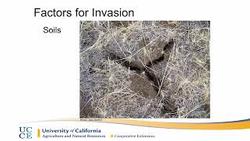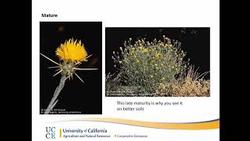California Rx Fire Videos
If you are interested in using prescribed fire to manage lands in northern California, this is a great place to start, with short videos on common uses and basic prescription parameters for utilizing a natural management tool that has shaped California’s flora for millennia.
This 16-video series focuses on the utilization of prescribed fire to manage California ecosystems, and was funded by a grant from the Western Sustainable Agriculture Research and Education (WSARE) program. The series was organized and hosted by Jeff Stackhouse and Lenya Quinn-Davidson of the University of California Cooperative Extension.
General Prescribed Fire Topics
Prescribed Burn Associations: Landowners applying fire to the land
John Weir, Oklahoma State University, Natural Resource Ecology and Management
John Weir is an expert in the application of prescribed fire and is responsible for sparking the vast interest in community-based burning in the southern great plains during his career at OSU.
Watch this short video on what prescribed burn associations are, how they work, and if it sounds like a fit for your area.
Protecting infrastructure before a prescribed fire
Yana Valachovic, University of California, Agriculture and Natural Resources
Yana Valachovic is a Registered Professional Forester and an expert in home hardening to reduce the risk of structural losses during wildfires.
In this video she discusses some of the basic precautions that should be taken prior to utilizing prescribed fire near structures or in the wildland-urban interface (WUI).
Weather monitoring for prescribed fire
Eamon Engber, National Park Service, Fire and Aviation Management
Eamon Engber is a fire ecologist for the National Park Service and has a wealth of knowledge on planning and implementing burns in diverse ecosystems of Northern California.
In this video, he describes common tools for weather monitoring on prescribed burns, he shares his favorite online weather resources, and describes ways to assess if timing is right to initiate your burn to meet your objectives and complete your project safely.
Use of Prescribed Fire to Manage Forested Systems
Common tribal cultural uses of fire in northwestern California: acorns and hazelnuts-basketry stems
Dr. Frank Lake, USDA Forest Service, Pacific Southwest Research Station
Frank Lake is an expert in traditional ecological knowledge and ethnobotany. In this video, he covers ecological and environmental factors that lead to successful cultural burning in northern California, as well as ignition patterns, seasonality, and cultural considerations for planning and implementing a successful burn to meet ethnobotanical objectives.
Prescribed fire in mixed conifer forests
Dr. Rob York, University of California, Agriculture and Natural Resources
Rob York is an expert in pyric silviculture in mixed-conifer forests in the Sierra Nevada. As a specialist for the University of California, Rob focuses on applied research of management strategies that reduce costs of forestry management while meeting objectives of tree health and growth and reducing risk of losses to wildfires. This is an incredibly informative video on basic prescription parameters, benefits of winter burning, and basic concepts of utilizing fire to manage mixed-conifer forests.
Using prescribed fire in management of ponderosa pine
Carl Skinner, Retired Geographer for the USDA Forest Service, Pacific Southwest Research Station
Carl Skinner has a wealth of knowledge about utilizing prescribed fire in forested ecosystems and an uncanny ability to storytell. He spent his career studying northern California’s forested ecosystems and has been promoting the use of prescribed fire for decades. This video touches on some of the basics of utilizing fire in ponderosa stands, including developing prescriptions and managing for healthy, open forest stands.
Prescribed burning in mixed conifer/tan oak forests: (Some of) what you need to know to implement a successful burn
Will Harling, Mid Klamath Watershed Council
Will Harling is co-director of the Mid Klamath Watershed Council and an expert at planning and implementing prescribed burns in very steep, rugged mixed-conifer/tanoak forests at the interface of public and private lands. In this video, Will discusses some of his experiences and lessons learned for burning in this fuel type, including weather prescriptions, unit layout and preparation, and the utilization of fire to make communities more resilient to wildfire.
Using prescribed fire in management of California black oaks
Carl Skinner, Retired Geographer for the USDA Forest Service, Pacific Southwest Research Station
Carl Skinner is retired from the USFS where he spent his career studying forested ecosystems and the art of utilizing fire to manage those diverse systems. In this video, Carl talks about the landscape context of black oaks in northern California, seasonality of burning, and the specific weather and fuel parameters that practitioners should target when utilizing fire to manage this valuable aesthetic, ethnobotanical, and wildlife resource of Northern California.
Prescribed fire for conifer management in oak woodlands
Eamon Engber, National Park Service, Fire and Aviation Management
Eamon Engber is a fire ecologist for the National Park Service and has been implementing fire in the Bald Hills of Redwood National Park for a decade. Conifer encroachment into meadows and oak woodlands is common across the west due to an overall decrease in the frequency of fire on the landscape. In this video, Eamon covers the basics of burning in these encroached systems and describes parameters for meeting the dual objectives of conifer mortality and oak conservation.
Use of girdling as a tool for oak woodland/prairie resoration
John McClelland, National Park Service, Fire and Aviation Management
John has been fighting woody encroachment for decades and has a wealth of knowledge in utilizing fire and mechanical techniques for prairie and oak woodland restoration in northwestern California. In this video, we asked him to speak specifically about the use of girdling to manage mature (seed source) conifers, which are too large to be killed with prescribed fire, and often can’t be felled without damaging the oaks that they’ve overtopped.
Considerations for prescribed burning in mechanically masticated fuelbeds
Dr. Jeff Kane, Humboldt State University, Fire Ecology and Fuels Management
Jeff Kane is a professor in Fire Ecology at Humboldt State University, where he studies fire effects in various fuel types, including masticated fuelbeds. In this video, Jeff discusses some considerations to keep in mind while burning masticated fuels, along with some pros and cons of burning in this fuel type.
Use of Prescribed Fire to Manage Rangelands
Use of prescribed fire in western juniper woodlands
Dr. Stephen Bunting, Retired professor at the University of Idaho, Forest, Rangeland, and Fire Sciences
Steve Bunting is an expert in controlling the encroachment of Western juniper into sagebrush steppe. Like other conifer encroachment in the west, juniper have expanded from their historical range with the suppression of wildfires. Bunting spent his career studying sagebrush ecosystems and investigating economically viable options for stopping the spread of Western juniper, including the use of prescribed fire. This video discusses prescriptions, timing, and seasonality of burning in sagebrush ecosystems to control juniper.
Prescribed fire in north coast chaparral
Norman Brown, Retired Deputy Chief of the CAL FIRE Mendocino Unit
Norm has been burning to enhance wildlife habitat in chaparral ecosystems for decades. In this video, he covers the basics of burning in chaparral fuel types, what you need for tools and control lines, what to expect for fire behavior, seasonality, and optimum weather parameters to decrease fuel loads and improve forage for ungulates.
Barb goatgrass control and fire
Josh Davy, University of California, Agriculture and Natural Resources
Josh Davy is a Livestock and Range Advisor and Certified Rangeland Manager for the University of California, where he has spent much of his career understanding how to control late-phenology invasive plants, including goatgrass, medusahead, and starthistle. In this video series, Davy covers multiple control options for each of these species, including the use of prescribed fire, and describes the necessary return intervals and/or follow-up treatments to successfully eradicate these noxious rangeland plants.
Medusahead control and fire
Josh Davy, University of California, Agriculture and Natural Resources
Josh Davy is a Livestock and Range Advisor and Certified Rangeland Manager for the University of California, where he has spent much of his career understanding how to control late-phenology invasive plants, including goatgrass, medusahead, and starthistle. In this video series, Davy covers multiple control options for each of these species, including the use of prescribed fire, and describes the necessary return intervals and/or follow-up treatments to successfully eradicate these noxious rangeland plants.
Yellow starthistle control and fire
Josh Davy, University of California, Agriculture and Natural Resources
Josh Davy is a Livestock and Range Advisor and Certified Rangeland Manager for the University of California, where he has spent much of his career understanding how to control late-phenology invasive plants, including goatgrass, medusahead, and starthistle. In this video series, Davy covers multiple control options for each of these species, including the use of prescribed fire, and describes the necessary return intervals and/or follow-up treatments to successfully eradicate these noxious rangeland plants.

